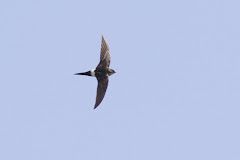




Photos (top to bottom): The sand dunes at Erg Chebbi; Yellow Wagtail (of the subspecies Iberiae or Cinereocapilla); Thick-billed Lark; Desert Sparrow; and White-crowned Black Wheatear
Mid-April saw me, with a couple of birding friends from England, travel to Morocco for a few days to catch up with some species that are very difficult to see in Europe. The trip started with a flight to Marrakech and took in the Atlas Mountains to see species such as Crimson-winged Finch, Alpine Chough and Moussier's Redstart, then east to the desert of Merzouga (via the famous Tagdilt Track) and then west to the Atlantic coast of Agadir (for Bald Ibis, gulls and waders) and then north to Merja Zerga for Marsh Owl. My impressions of north Africa had always been tainted by a brief holiday to Tunisia about 10 years ago where we stayed in a soul-less hotel, were constantly hassled by locals and then got food poisoning. So I was a little apprehensive about going back to the region. But I have to say that this trip has completely changed my opinion of north Africa. What a country. The people were, with the exception of the EMP (Evil Marsh People) at Merja Zerga, extremely friendly and hospitable, the food was excellent (tagines, I love 'em) and the scenery dramatic (from the beautiful Atlas mountains to the orange sand dunes of Erg Chebbi, the coastal cliffs of Tamri and the semi-desert plateaus around the centre. Simply stunning. And of course, extremely cheap (one of the places we stayed in cost us GBP 4 each for the night!).
Overall we saw 214 species of bird including some very sought-after species such as Thick-billed Lark (what a character!), Desert Sparrow, Hoopoe Lark, Blue-cheeked Bee-eater, Desert Warbler, Fulvous Babbler, Tristram's Warbler, Black-crowned Tchagra plus Lanner, Barbary Falcon and "Pharaoh" Eagle Owl. Top class birding.
The poverty is difficult to handle with many people clearly living on next to nothing. No matter where we stopped along the way, in the middle of the desert, in the mountains or on the plains, inevitably within about 2-3 minutes we would be approached by someone who seemed to appear out of thin air. One guy we spoke to lived in a cave and caught birds with home-made traps for food. Many of these people were simply lonely and very keen to chat rather than looking for any handouts but this was different at Merja Zerga. This marsh is the site where, until recently, the last known Slender-billed Curlews wintered (now presumed extinct). Now it is still very popular with birdwatchers due to its obliging Marsh Owls. So the locals are used to lots of birdwatchers turning up in the area. This shows as, as soon as you arrive on site, masses of children and adolescents turn up claiming to be able to show you the owls (for a fee, of course). We lost count of how many "official wardens" we bumped into, most wearing nothing on their feet and claiming to be the authority who must be paid before we were allowed to look for birds. We had to give one guy the last of our digestive biscuits to go away, taking his yappy dogs with him!
The traffic police were also a constant presence - seemingly two guys on every junction. We were stopped once for speeding and told to pay a fine of 400 Dirhams (about GBP 23) which could be reduced to 200 Dirhams if we didn't want any "paperwork". What a scam.
I couldn't complete this entry without a note on the famous Tagdilt Track. This is, as it says on the tin, a track (definitely not a road) that takes you to Tagdilt from Boumalne du Dades (in the mid-east of the country). It is a high plateau of semi-desert between the High Atlas mountains and a slightly lower range of mountains to the south. It is one of THE best places known to man to see all manner of LARKS. It also doubles up as the local refuse tip (with plastic bags galore) and a loitering area for the local stray dogs, all of which makes for a unique birding experience. But what a place - we saw Thick-billed, Desert, Bar-tailed, Temminck's, Hoope and Short-toed Larks plus Red-rumped Wheatear, Desert Wheatear, Lanner, Black-bellied Sandgrouse, Cream-coloured Courser not to mention numerous Black Kites, Montagu's Harriers and Booted Eagles. The one lark we missed, which is very scarce at Tagdilt, is the Dupont's Lark. This bird is one of the trickiest species to see in Europe and North Africa - it sings at night and, according to the bird log at the Auberge Soleil Bleu (the closest accommodation to the Tagdilt Track) they "run faster than Linford Christie and hide better than Lord Lucan". Hmm...
Definitely a place to revisit!








